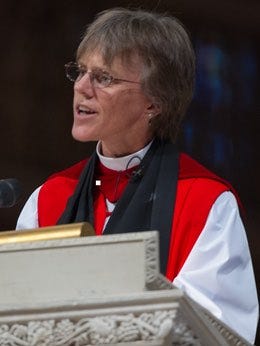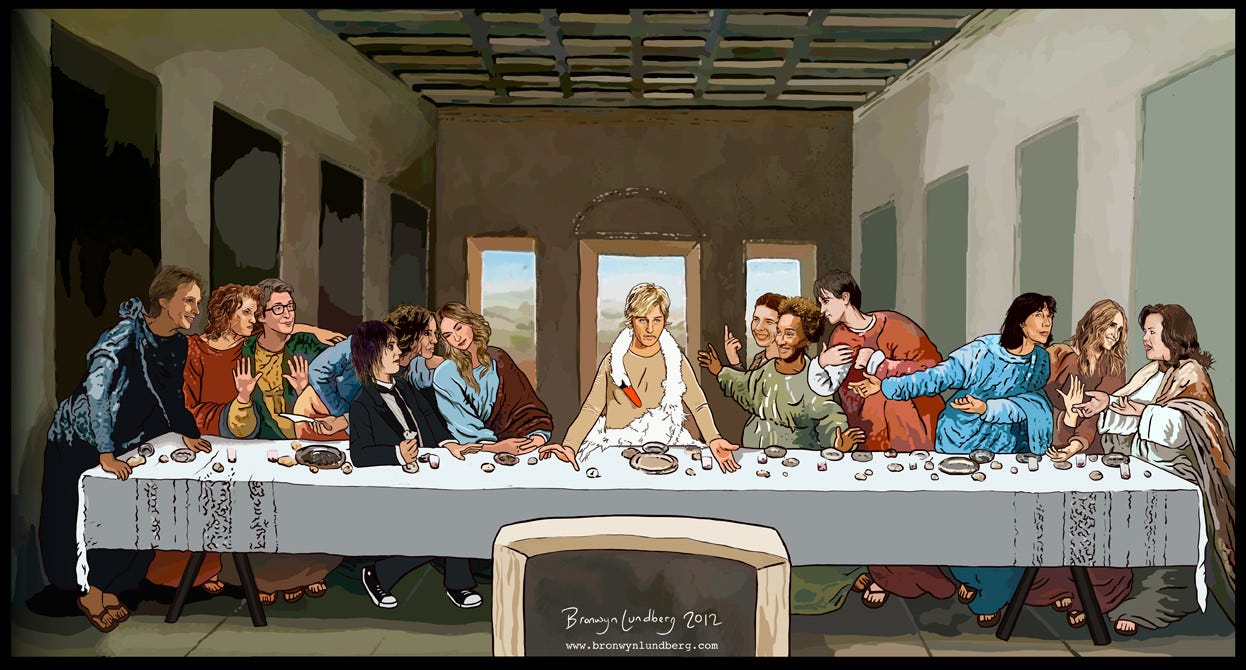Is Gender a New Religion? Or a Very Old One?
The parallels between gender ideology and ancient Gnostic beliefs
In 1945, when a humble Egyptian peasant was digging the soil in Nag Hammadi, just around the bend in the Nile from Luxor and the Valley of the Kings, he chanced upon an ancient pot. Like better-known Egyptologists, he smashed this historic find open, in the hope of finding treasure, but was disappointed to find the pot only contained some old writings. Taking them home anyway, his mother put most of the documents to use as firelighters.
It was only when an associate tried selling the remaining artefacts to a local dealer in antiquities when it was realised that this discovery was of early Christian texts that had not made it into the official Bible. At least one of these texts was known from other sources, but the majority of the hoard was thought to have lain hidden for more than a thousand years. A bidding war ensued, and so various documents from Nag Hammadi made their way into museum collections and private hands.
For the first two or three centuries AD, the subject of what was, and what was not, Christian belief was highly contested. There were many factions among the early Christians, some of which may have been inspired by Buddhist missionaries who arrived in the Mediterranean region from India. The Gnostic sects claimed special knowledge, not as in “I happen to know a really good place for lunch”, but in the sense of the Greek word gnosis, meaning insight. Gnosis was not meant to be shared with non-believers; it was for sect members only. There was no point debating gnosis with people who didn’t have it, and how to get it was a secret.
A Gnostic text called ‘Discourse on the Eighth and Ninth’ refers to the upper levels of insight which can be achieved by believers who have already completed the first seven levels. If that sounds like Scientology, it may not be a coincidence. Whoever achieved gnosis supposedly became not just a Christian, but a Christ themselves. Why not write your own gospel, in that case?
Another discovered text, the ‘Allogenes’, explains how introspection leads the Gnostic to identify as holy: “…[I was] very disturbed, and [I] turned to myself… [Having] seen the light that [surrounded] me and the good that was within me, I became divine.” Literally being Jesus is of course one of the more common delusions found in the psychiatric ward.
The Gnostic is a ‘disciple of their own mind’. Some early Gnostics thought this special insight might only be achieved by one in a thousand people, or less, whereas what became known as the Orthodox and Catholic churches were open to all-comers. The theologian and initiator of Latin scripture, Tertullian, who lived in what is now Tunisia in the second century AD, mocked the Gnostic sect of the poet Valentinius, stating that its members:
“first beset all access to their group with tormenting conditions; and they require a long initiation before they enroll their members, even instruction for five years for their adept students, so that they may educate their opinions by this suspension of full knowledge, and, apparently raise the value of their mysteries in proportion to the longing for them which they have created. Then follows the duty of silence…”
The long controversy between heretics and mainstream Christianity led to the Roman emperor Constantine setting up the Council of Nicaea in 325 AD. This gathering of church leaders nailed down Christian belief as being in one male creator God responsible for everything that existed, one and only son of God born of a virgin offering salvation through resurrection, and a holy spirit to round out the Trinity. For those of us who have heard the Nicene Creed repeated many times, it may come as a surprise to find out that in the early Christian era, all of these basic beliefs were disputed, which is why the Creed had to be agreed on by bishops from the dominant regional factions within the Roman Church.
For Gnostics, the God of the standard Bible is a minor deity sometimes called the demiurge, a jealous male who merely pretended that there were no other gods. Polytheism had been standard practice in the Roman empire, of course. Being secretive and mysterious, Gnostics mostly managed to avoid being ravaged by lions in the arena; a spectacle which had taken over from gladiatorial combat as top-billed entertainment because putting Christians to death was much cheaper for the Roman authorities. The Gnostics were reportedly uninterested in provoking martyrdom because they didn’t consider bodies and their fate as being all that important. Their inner essence was everything.
The Council of Nicaea also carried out the editorial task of deciding which documents would be considered canonical in the Bible, throwing out the Gnostic and other texts which were contesting and confusing the Christian narrative. It is possible that the pot found at Nag Hammadi was an early example of a data backup strategy, with Gnostic sect members hiding texts underground which became definitively heretical once the bishops published their decisions from Nicaea.
Elaine Pagels, who obtained her doctorate from Harvard and was appointed chair of the religion department at Barnard College, Columbia University in the mid 1970’s, published a popular account of the Nag Hammadi texts in 1979. Her book ‘The Gnostic Gospels’ appeared at a time when second-wave feminism was still a thing. It made the case that the Gnostic sects had been in favour of sex equality, with women priests recorded in the early Church. This was not merely a case of equality in the workplace for religious employees, but a radical reshaping of what Christianity had meant since the time of Constantine.
In the third chapter of her book, Pagels pointed out that the Abrahamic religions of Judaism, Christianity and Islam are relatively unusual in declaring that God is exclusively masculine. The Gnostics disagreed with mainstream Christians and each other on the subject of gender, as they did on many topics, with the Gospel of Thomas stating “...every woman who will make herself male will enter the Kingdom of Heaven”. Other Gnostics prayed to a dualistic Divine Father and Mother, while some insisted that the Holy Spirit must be feminine. The Gnostic text known as the ‘Secret Book’ stated “She became the Mother of everything, for she existed before them all, the mother-father”.
In the Gnostic ‘Apocalypse of Adam’, a parthenogenic goddess is the source of all human life: “She came to a high mountain and spent time seated there, so that she desired herself alone in order to become androgynous. She fulfilled her desire, and became pregnant by her desire…” Valentinius opined that this goddess called Wisdom, being a single parent, raised her demiurge offspring to manage the mess she previously made by bringing forth all living creatures in this one-sided manner. According to one Gnostic source, it was Wisdom that saved Noah and his family from the great flood caused by her bad-tempered son. In those days, the symbol of the rainbow had something to do with God, rather than Pride.
The ‘Trimorphic Protennoia’ discovered at Nag Hammadi contained words spoken by a divine feminine voice: “Now I have come a second time in the likeness of a female… I have revealed myself in the Thought in the likeness of my masculinity” and “I am androgynous. [I am both Mother and] Father, since [I copulate] with myself… [and with those who love] me…” A Gnostic poem called ‘Thunder, Perfect Mind’ contains another divine revelation in a feminine voice: “I am the whore, and the holy one. I am the wife and the virgin.” This Gnostic goddess is sex-positive.
According to Pagels, notions of the divine feminine were driven out of official Christianity by the year 200 AD. With that shift in theology, women were also prevented from being priests in the official Roman church, possibly as a result of Greek Jews converting to the religion and bringing their orthodox traditions with them. Tertullian flamed an African Gnostic priestess he called “that viper”, stating: “It is not permitted for a woman to speak in the church, nor is it permitted for her to teach, nor to baptize, nor to offer [the eucharist], nor to claim for herself a share in any masculine function – not to mention any priestly office.”
Exactly 1700 years after the Council of Nicaea, a high priestess scorned a newly inaugurated President Trump from the pulpit of the gothic Washington National Cathedral. The Right Reverend Mariann Edgar Budde spake thus: “In the name of our God, I ask you to have mercy upon the people in our country who are scared now. There are gay, lesbian and transgender children in Democratic, Republican and independent families. Some who fear for their lives.”


Let’s note that Budde said ‘our God’ rather than the more usual ‘God’, implying that there are diverse other gods. Just as in Gnostic times, it is possible to create new gospels and parables of our own devising, in this case featuring an evil King who gave the executive order that all transgender children be cast unto the wilderness. A Herod for the age of intersectionality.
When I visited Coventry Cathedral in central England during 2023, a giant Progress Pride flag hung from the ceiling. A special exhibition of LGBTQIA+ artwork featured transgender celebrities including Munroe Bergdorf and Elliot Page, and a depiction of British Olympic diving champion Tom Daley as Saint Sebastian, shot through with arrows. As the cathedral’s website explained this scene of sadistic torture, which appears to have mixed up Saint Sebastian, Jesus and the Weimar Republic’s downfall, “The crown of thorns made from pink triangles references the persecution of homosexual people during the Nazi regime.”
Referencing the late Derek Jarman’s film on Saint Sebastian in the cathedral was a bold move, given Jarman’s known views on the age of consent, and the failure of the Church of England to deal with the abuse of children by its members.
In 2024, the church’s most senior cleric, Archbishop of Canterbury Justin Welby, quit the top job after failing to do anything about psychopathic sadist John Smyth when he had the chance to, between 2013 when Welby was appointed and 2018 when Smyth died. Smyth’s victims included at least 30 boys in the UK and another 85 in Africa, although the total number of children he tortured and abused may never be known. Smyth carried out his crimes in the 1970’s and 1980’s when the British advocacy group ‘Paedophile Information Exchange’ or ‘PIE’ was supported by radical progressives.
Despite the Right Reverend Budde’s dire warnings to President Trump, the greatest risk to children of all kinds is not official scepticism about gender identity; it is the erosion of safeguarding and the insistence that mere consent can substitute for moral boundaries. Socially assimilated gay and lesbian youth are of no use in the revolutionary vanguard, and so the goal of queer theory is to Make Homosexuality Dangerous Again.
James Lindsay has documented the Gnostic influence on progressive politics today. Just as Catholicism experienced an insurgency from liberation theology in the 1960’s, it appears that Protestant churches have undergone a Gnostic incursion since Pagels published her book on alternatives to traditional Christianity in the late 1970’s. As I wrote in my review of The Well of Loneliness by Radclyffe Hall (1928) official Catholic doctrine remains that there is no such thing as a gendered soul, but the neo-Gnostics have taken that idea and run with it. And Exulansic has noted how factions within the transgender community resemble church denominations.
Some believers have taken the Gnostic idea of a self-made salvation to its logical conclusion. Jo Clifford’s one-transwoman play “The Gospel According to Jesus, Queen of Heaven” has been performed in Calvinist Scotland, sexological ground zero Germany and liberation theology’s territory of Brazil since its debut in 2009. The play has been welcomed in actual cathedrals and churches in the USA, not just edgy arts venues. The show’s website promises that we may “Join Queen Jesus for a revolutionary queer ritual in which bread is shared, wine is drunk and familiar stories are reimagined by a transgender Jesus.”
Since long before the opening ceremony of the 2024 Paris Olympics, which featured a set-piece reportedly inspired by Jan van Bijlert’s painting “The Feast of the Gods”, the queer Last Supper has been rendered so many times that it’s practically a genre. In 2012, artist Bronwyn Lundberg produced an all-lesbian Last Supper with Ellen DeGeneres in the central seat, wrapped in a dead swan.
While the transgender phenomenon has many facets – political, medical, social – talk of gendered souls imprisoned in human bodies is classic Gnostic heresy, and needs to be recognised as a supernatural claim. It’s hard enough being Jesus without being subject to the attentions of the gender clinic as well. Who knows how many of the advocates for invasive medical and surgical procedures on gender non-conforming people are motivated by self-affirmed religious belief?
Part 2 of Daniel Howard James’ series on gender ideology and Gnosticism appear Saturday, May 24th
Genspect publishes a variety of authors with different perspectives. Any opinions expressed in this article are the author’s and do not necessarily reflect Genspect’s official position. For more on Genspect, visit our FAQs.









Thanks for this and looking forward to the next segment. Yes, a resurgence of gnosticism has been percolating in the culture for some time now, and has been manifesting in pop culture via books like Byrne's The Secret, and the new spiritual fads like Wicca and transhuman movements. The idea is that armed with the correct knowledge (gnosis) imparted by an elite knower (influencer) one can rise above the restraints of mere physical reality. This is implicit in the idea that it is possible to transcend the imposed sex assigned at birth and become what you want.
All of the world's major religions as well as many if not most indigenous religions start with claims by the religion's founders and/or followers that he/she received revelations of secret knowledge from divine presences. In most or all of these stories, the revelations occurred when the founder was engaged in ascetic practices, including extended fasts in wilderness areas, days or weeks of uninterrupted meditation, use of psychedelic drugs, prolonged dancing to rhythmic music (drumming), and/or acts of "mortification" of the body (self-flagellation). The context of the revelations is in most or all religions reported as a dream, a waking vision, or some other altered state of consciousness induced by the practices just listed.
For many adherents of these religions, the ecstatic experiences described by "saints," "gurus," "prophets," etc. are the primary draw to membership. As it turns out, it is difficult or impossible to achieve the states of mind necessary to produce these experiences without entering a monastery where the cultivation of such states is the primary focus. Religions that require ascetic practices and monastic lifestyles tend to die out within a generation or two, so religious leaders who want to establish a permanent church tend to moderate or marginalize "contemplative practices." Even so, contemplative monasticism remained the ideal of the Roman Catholic Church until very recently, and anyone who reads the saints will find a lot of gnostic and ascetic themes in their accounts.
The highs created for at least some practitioners by gnostic/ascetic/contemplative practices are reported to be among the most profound and ecstatic obtainable in human life, and as such, they can become very addicting. Practitioners are disappointed when they discover that what goes up also comes down. They long to remain in these exalted states, and are often taught that the greatest saints actually do/did so. (In Buddhism, highly esteemed teachers are referred to as "Enlightened Beings.")
People who undertake "gender reassignment surgery" do indeed talk about the surgery as a transformative experience very similar to a gnostic initiation rite. I am aware that at least one famous gender surgeon gives her post-surgical patients a necklace with a butterfly pendant symbolizing the emergence of the liberated inner spirit. Because we have so little follow up data on men who have completed surgical transitions, I can only guess that many of these patients must have to navigate some type of let down experience subsequently. How they adapt to coming down from the high they anticipated and perhaps felt probably influences the degree to which they regret or do not regret their choice to transition, or whether they move on to other extreme strategies to achieve a similar sense of being reborn as someone else.